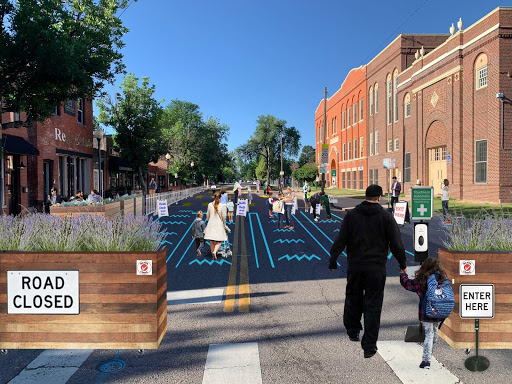Take it Outside: Street Space for Schools

Covid-19 brought Denver its first shared streets and open streets for physical distancing. Shared streets are exactly what they sound like: streets where all transportation modes are allowed, although motor vehicle thru-traffic is prohibited. On shared streets, all road users travel at safe speeds and prioritize vulnerable road users, giving them more space than is afforded by multi-use paths or sidewalks. Open streets do not allow motor vehicles (with the possible exception of necessary maintenance vehicles), and were implemented in several Denver Parks in April. Open streets are now in place to support restaurants on Glenarm, Larimer and Pennsylvania Streets. With the 2020-2021 school year approaching and several school districts planning for full-time in-person education, it is time to bring safe streets to schools—and take school to the streets.
As a parent, I have concerns about sending my children to full-time in-person school this fall. I’m even more concerned for my children’s teachers, support staff and grandparents. Yet I understand the importance of quality education, especially for vulnerable students. In-person schooling is critical for economic recovery, as well. If safer streets for outdoor classrooms become a reality in the age of Covid-19, we will cultivate the best of all possible worlds: public health protection and economic recovery alongside myriad benefits in education and child development. Certainly the global pandemic lends urgency to outdoor learning; but a switch to fresh air and sunshine can provide numerous benefits to school communities whether or not the pandemic continues for months or years to come.
Outdoor education has merit in its own right. This fall, those benefits can complement public health and safety in unique and cost-effective ways. Outdoor spaces around schools serve two essential purposes in the context of the Covid-19 pandemic. First: safely and efficiently admit healthy kids to school. Second: prevent disease from spreading among asymptomatic carriers at school, no matter their age.
Expanding school grounds to include public city property makes room for the unprecedented safety procedures facing schools, staff, and families this fall. Shared and open streets are ideal for providing the necessary space to efficiently conduct health checks. They will also minimize gridlock at drop-off, which in turn could help teachers and staff spend less time conducting health checks and more time teaching.
We don’t have to guess at what this might look like. Last month, the National Association of City Transit Officials released recommendations for school streets, including clear markings for drop-off and pick-up spacing, a waiting area for symptom checks, and outdoor classroom and education space. All of these components contribute to a safer school environment, minimize risk to teachers and staff, and protect the greater community from Covid-19 outbreaks.
Even if indoor learning proves to be safe for children and their communities, outdoor learning could be a welcome contingency plan or additional layer of safety. Consensus is building around the idea that Covid-19 transmission primarily occurs indoors. Infection is nearly 20 times more likely indoors than out. Outdoor learning is a proactive measure to ensure that students safely receive the education, services, food and social connections that help them thrive.
In addition to making space for outdoor classrooms, open or shared streets will also provide locations for recess, physical education and arts. This would allow school grounds to be used for outdoor learning during the school day without eliminating recess mainstays such as four-square. A long stretch of asphalt could be a larger-than-life canvas for art students. Music could take place next to a physical activity zone, much like a pep band at a basketball game. With those activities moved to streets, sturdier structures could be placed on school grounds for outdoor learning during inclement weather. During dangerous weather, students could attend school in smaller groups or learn remotely from home.
The verdict on recess is clear: outdoor is best. There are documented benefits to outdoor classes, as well. One study indicates that simply changing the location of one class from indoors to outdoors helps students focus. Another shows that outdoor education helps reduce the stress hormone cortisol in children. These studies build on older evidence that outdoor education is fun and healthy, supports healthy child development and community engagement, and improves student performance. What greater gift could we give to children—and their communities—than to provide all of these benefits, simply by taking advantage of existing public space?
For Denver Public Schools and many other school districts, the pathway to this gift may be elegantly simple: partner with local transportation departments to designate streets for education. In the case of Steele Elementary, the path is clear: Marion Parkway is a shared street already. Large trees in the median create a beautiful natural canopy and demarcations for outdoor classrooms. East High School overlooks 16th Avenue, another shared street. My hope is that similar paths can clear for schools across Denver and beyond, and that neighborhoods and administrators support educators to take full advantage.
Certainly there will be logistical hurdles and funding concerns. That said, Denver has made open streets work for restaurants. So, why not for schools? To be clear, there is no need to impose open streets on school communities that don’t want them. At the same time, the option should be available to those that do. This fall and beyond, converting street space to educational space could make all the difference not only for students and teachers, but for every Denver resident: working parents, their coworkers and employers, custodial and paraprofessional staff, grandparents, cousins, neighbors and friends. Done right, it would bring a breath of fresh air to a suffocating crisis.
Renderings by Brittany Spinner
Streetsblog Denver informs the movement for sustainable transportation and a livable city. Give $5 per month.



